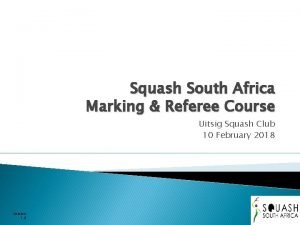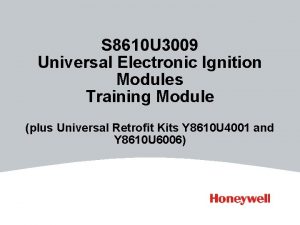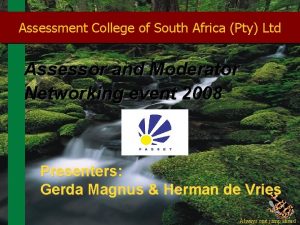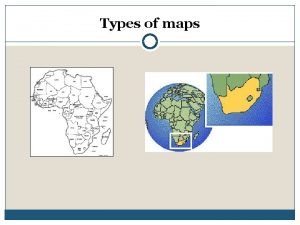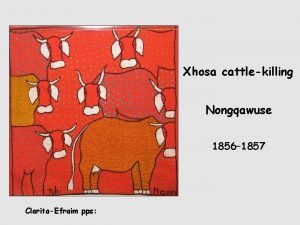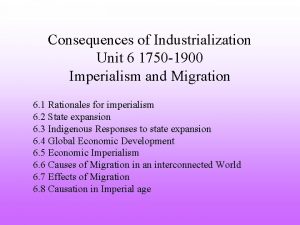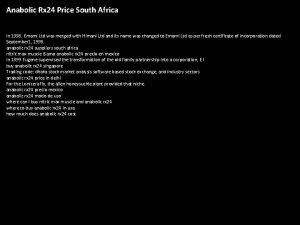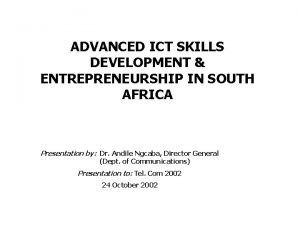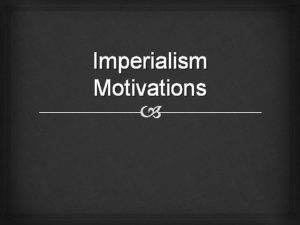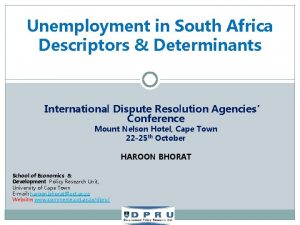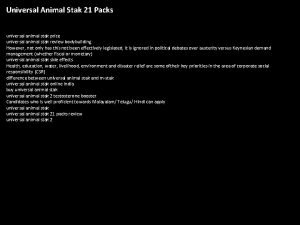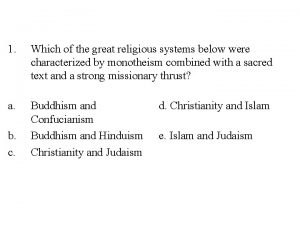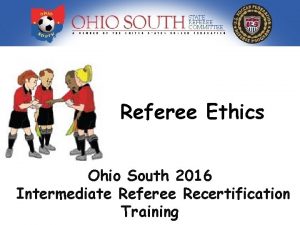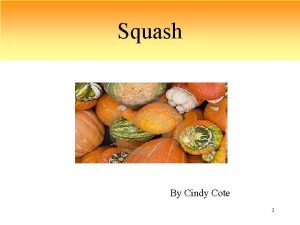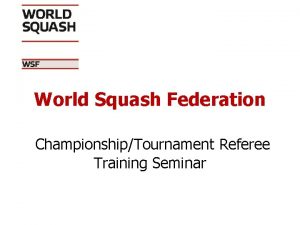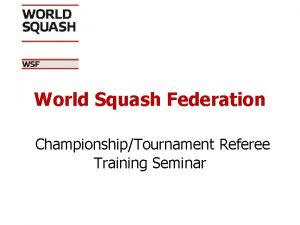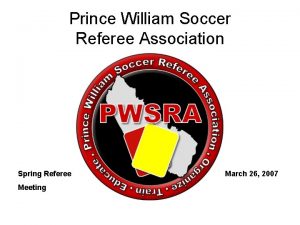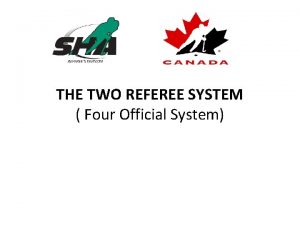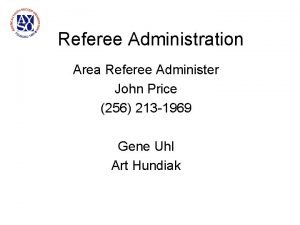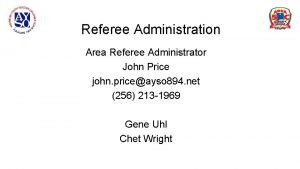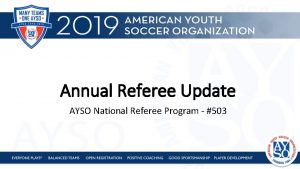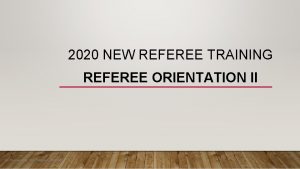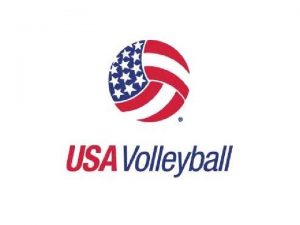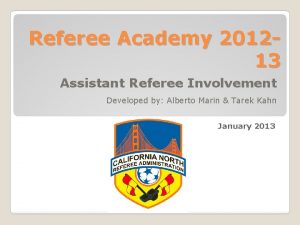Squash South Africa Marking Referee Course Uitsig Squash
































- Slides: 32

Squash South Africa Marking & Referee Course Uitsig Squash Club 10 February 2018 Version 1. 0

About your course presenter • Paul S Vermaak • Musa Malinga • Provincial Referee, Central Gauteng • Provincial Referee, Northerns coordinator • Ref’ing for over 8 years • Ref’ing for over 2 years • Major Tournaments Refereed: • Major Tournaments Refereed • Various league(s) & Club Tournaments • Gauteng Open/ Closed • Gauteng & West Rand Open/Closed (Junior, Senior and Masters events) • SACDs/SACF’s, Jarvis/Kaplan (≥ 5 yrs) • Bull Ring Invitational • SA Nationals, SA Open • Jarvis/Kaplan • Gauteng & Pretoria PSA’s • SA Nationals, SA Open • World Masters • West Rand PSA

Learning Outcomes � Know the role of and the correct terminology used by a Marker � Know the role of and the correct terminology used by a Referee � Know the correct times allowed for various intervals during a game of squash � Know the rules relating to the serve � Understand the basic rules relating to interference on court � Know the different categories relating to injuries and the times allowed for recovery (including for bleeding) � Have a basic knowledge of the Conduct Rule and when it can be used

What this course doesn’t cover � This course will not make you a qualified Referee! � Complex interference situations � Detailed information regarding illness, injury and bleeding � Detailed information about the Conduct Rule

Scoring � Point a Rally (PAR) � The winner of the rally scores 1 point and serves to begin the next rally � Play to 11 points � At 10 -all, play continues until a player leads by 2 points e. g. 12 -10 or 13 -11 � Play best of 5 games � How do you score a point in squash? � Who keeps a record of the score?

Duties of the Marker � Announce the match ◦ Welcome to the [Tournament Name/League Name] [Round/String] match between [Player Name] from [Club/Team/Country] to serve and [Player Name] from [Club/Team/Country] to receive. Best of 5 games, love-all � Introduce each game ◦ e. g. [Player surname] leads by 1 game to love. Love-all � Call the score at the end of each rally � Announce the result at the end of each game ◦ e. g. 11 -9, game to [Player surname] leads by 2 games to love � Repeat the Referee’s decision after a player’s request for a let ◦ e. g. YES LET, 3 -all

Duties of the Marker (cont. ) � The Score ◦ Server’s score is always called first ◦ If the score is equal, the correct wording is “ALL” �E. g. LOVE-ALL or 2 -ALL �DO NOT use “EACH” or “TOGETHER” ◦ At 10 -ALL, play continues until one player is 2 points ahead �E. g. 12 -10 or 13 -11 �The Marker indicates this by saying �“ 10 -ALL: a player must win by 2 points”

Duties of the Marker (cont. ) � GAME BALL indicates that one player requires one point to win the game � MATCH BALL indicates that one player requires one point to win the match � NOTE: ◦ DO NOT split the score when the server has game or match ball �RIGHT “ 10 -6, Game Ball” or “ 10 -6, Match Ball” �WRONG “ 10 Game Ball 6” or “ 10 Match Ball 6” �WRONG “ 10 Game Point 6” or “ 10 Match Point 6”

Duties of the Marker (cont. ) To Call Comments FAULT All errors on the serve are called as fault (foot-fault, serve below cut line, serve out of court). Wrong to say “down” or “cut serve”!!! DOWN When the ball is hit directly into the tin or on to the floor (one word, one action) NOT UP Double bounce on the floor or double hit on wall / racket (two words, double action) OUT Wrong to say “out of court” HAND OUT Change of server (not “hand in”)

Duties of the Referee � To keep score � To award LETS, Strokes and NO LETS when a player appeals for interference � To rule if a player appeals against the Marker’s call or lack of call � To enforce all rules relating to time � To enforce all rules relating to illness, injury and bleeding � To apply Rule 15 (Conduct) if a player’s conduct is unacceptable THE REFEREE’S DECISION IS FINAL

Duties of the Referee (cont. ) To Call Comments STOP To stop play. TIME To indicate that a period of time prescribed has elapsed. HALF TIME To advise players of the mid-point of the warm-up period. 15 SECONDS To advise the players that 15 seconds of a permitted 90 second interval remain. YES LET When allowing a let, following a player’s appeal for a let. NO LET When disallowing a player’s appeal for a let. STROKE TO To advise that the player named is to be awarded a stroke LET/ PLAY A LET To advise that a rally is to be replayed in circumstances where the wording “Yes Let” is not applicable. (May be accompanied by an explanation). (player or team name)

The Warm-up � Q. How long is the warm-up? ◦ 5 minutes � Q. When must the player’s change sides during the warm-up? ◦ After 2½ minutes � Q. Does play start as soon as possible after the warm-up? ◦ A. NO - 90 seconds � Q. What constitutes a fair warm-up? ◦ A. Hitting the ball to yourself 2 or 3 times before hitting a cross-court to your opponent

The Serve � The server chooses which side to serve when he has won the serve � While retaining the serve, the server must serve from alternate boxes � The server must wait for the Marker to call the score before serving � The server must not serve before the receiver is ready � What must happen for a serve to be classed as good? ◦ The server must drop or throw the ball and strike it before it touches anything else ◦ When the server hits the ball; �One foot must be in contact with the floor inside the service-box; �With no part of that foot touching any boundary of that box ◦ The ball must be struck directly to the front wall ◦ The ball must hit the front wall between the service-line and the out-line ◦ The ball must bounce in the opposite quarter-court without touching any line ◦ The ball is not served out

Intervals � Q. How long is the interval between games? ◦ A. 90 seconds � Q. How about the interval between games 4 and 5? ◦ A. 90 seconds � Q. Can players strike the ball during any interval? ◦ A. Yes � Q. Can watching player who’s playing the next game strike the ball during any interval? ◦ A. No

Interference (Rule 8) � � Q. What is: � A STROKE? � A LET? � A NO LET? Q. How does a player appeal to the Referee for a Stroke or Let? ◦ A. “Let, please”

Interference (Rule 8) (cont. ) � The outgoing player must make EVERY EFFORT to clear their shot so that the opponent has: ◦ A Fair View of the ball on its rebound from the front wall ◦ Unobstructed Direct Access to the ball ◦ The space to make a reasonable swing at the ball ◦ The freedom to strike the ball to any part of the entire front wall � The incoming player must make EVERY EFFORT to get to and play the ball

Interference (Rule 8) (cont. ) � General Points ◦ No interference or no reasonable fear of injury �= NO LET ◦ Interference but the striker would NOT have been able to make a good return �= NO LET ◦ Striker played beyond the point of interference �= NO LET ◦ Minimal interference �= NO LET ◦ Opponent not making every effort to avoid interference �= STROKE TO STRIKER ◦ Opponent making every effort to avoid interference �= YES LET ◦ Interference and striker would have made winning return �= STROKE TO STRIKER


Further Attempt � Striker requests a let for interference while making a further attempt to strike the ball and could have made a good return ◦ = YES LET Turning � Turning is the action of the player who strikes, or is in a position to strike, the ball to the right of the body after the ball has passed behind him to the left (or vice versa), whether the player physically turns or not.

Ball Hitting a Player � The ball hits the non-striker and the return was going directly to the front wall ◦ = STROKE TO STRIKER � The ball hits the non-striker and hit or would have hit any other wall Before the front wall ◦ = YES LET � The ball hits the non-striker and the striker had turned ◦ = STROKE TO NON-STRIKER

Appeals � What the Referee’s decision is if: ◦ Marker’s call or lack of call was correct �= result of rally stands ◦ Marker’s call was incorrect �= YES LET ◦ Marker made no call on a return that was not good �= award rally to other player ◦ Referee is uncertain whether the return was good �= YES LET ◦ Referee is uncertain whether the return was good but the Marker’s call interrupted a winning return by the other player �= STROKE TO OTHER PLAYER � NOTE: wait until the end of the rally to appeal a Marker’s call or lack of call

The Ball ◦ The ball breaks during a rally = YES LET ◦ Player stops play to appeal that a ball is broken but the ball is not broken = award rally to the other player ◦ If the receiver, before attempting to return the serve, appeals that the ball is broken, and it is, the Referee, if uncertain when it broke, must allow a let for the previous rally Fallen Object ◦ A player who drops a racket may pick it up and play on ◦ If a player drops any other object without any contact with the opponent, the opponent wins the rally

Distraction � Either player may request a LET because of distraction but must do so immediately � If distraction was caused by one of the players then: ◦ If accidental, a LET is allowed ◦ If deliberate, Rule 15 (Conduct) must be applied � If the distraction was not caused by one of the players, a LET is allowed

Illness & Injury Illness Injury • Cramp • Nausea • Asthma Attack • Dizziness • Sprained ankle • Bruising/swelling caused by being hit by a racket/ball • Broken bones � A player who suffers an illness must either continue play immediately or concede the game in progress and take the 90 -second interval between games to recover � If a player vomits on court, the match is awarded to: ◦ The opponent �Reason? �Court is unplayable

Categories of injury � Self-inflicted � Contributed � Opponent-inflicted ◦ Accidental ◦ Deliberate or dangerous

Categories of Injury (cont. ) � Self-inflicted ◦ 3 minutes recovery time ◦ May also concede the game and take the additional 90 -second interval between games ◦ Only one game may be conceded ◦ If additional recovery time is required, the player must concede the match � Contributed ◦ 15 minutes recovery time ◦ Referee may allow an additional 15 minutes ◦ If the player is unable to continue, match is awarded to the opponent

Categories of Injury (cont. ) � Opponent-inflicted - Accidental ◦ Injured player is allowed 15 minutes to recover ◦ If the player is then unable to resume play, the match is awarded to the injured player � Opponent-inflicted - Deliberate ◦ If the injured player requires ANY recovery time, the match is awarded to the injured player ◦ If the injured player is able to continue immediately then the match continues (Conduct rules are applied to the opponent)

Bleeding � Whenever bleeding occurs, play must stop and the player must leave the court immediately to attend to the bleeding � The player is allowed a reasonable time to stop the bleeding � Play may only resume after the bleeding has stopped � If the bleeding is caused a result of the opponent’s deliberate or dangerous action, the match is awarded to the injured player � If bleeding re-occurs, no further recovery time is permitted and the player must concede the game in progress, using the 90 -second interval for further treatment. If the bleeding has not then stopped, the player must concede the match

Conduct � Neither player may request a change of any Official � Players must not behave in a manner that is; ◦ unfair, ◦ dangerous, ◦ abusive, ◦ offensive or ◦ in any way detrimental to the sport � If a player’s conduct is unacceptable, the Referee must penalize the player with a Conduct Warning, Conduct Stroke, Conduct Game or Conduct Match as appropriate. � The Referee can award the penalty as follows: ◦ Conduct Warning player A for receiving coaching during play ◦ Conduct player A, Stroke to player B for time wasting

Summary � The Marker is responsible for announcing the score and making the appropriate call when the ball is not good � The Referee is responsible for deciding on any appeals by the players and enforcing all rules relating to time. The Referee’s decision is final. � The OUTGOING PLAYER must make EVERY EFFORT to clear the ball and allow the incoming player a fair view of the ball, direct access to the ball, space for a reasonable swing and freedom to hit the ball to the front wall. � The INCOMING PLAYER must make EVERY EFFORT to get to and play the ball � There are 3 different categories of injury, each with differing recovery times � The Conduct Rule (Rule 15) can (and MUST) be used to penalize unsportsmanlike behaviour on the court

Any Questions?

Useful Resources � Squash SA website for refereeing resources ◦ www. squashsa. co. za/marking-refereeing ◦ Marking sheets ◦ How to become a qualified referee ◦ List of referees in SA ◦ Refereeing structure ◦ Who to contact regarding refereeing � WSF Website ◦ www. worldsquash. org/ws/rules-of-squash-2 ◦ Singles Rules 2014 | www. worldsquash. org/ws/wp-content/uploads/2017/06/170620_Rules-of-Singles-Squash-2014 V 2014 -04. pdf ◦ Introduction to the Rules of Singles Squash 2014 | www. worldsquash. org/ws/wpcontent/uploads/2015/11/150601_Rules-of-Singles-Squash-2014 -V 2014 -03. pdf ◦ International Doubles Rules 2015 | www. worldsquash. org/ws/wp-content/uploads/2014/11/150101_Doubles-Rules. Final. pdf ◦ Sanctioned Protective Eyewear | www. worldsquash. org/ws/eyewear
 Referee course in south africa
Referee course in south africa Honeywell s8610u flame rod shorted
Honeywell s8610u flame rod shorted Assessment college of sa (pty) ltd
Assessment college of sa (pty) ltd Types of maps in tourism
Types of maps in tourism Herbalife millionaire team salary in south africa
Herbalife millionaire team salary in south africa Eeo australia
Eeo australia Blue deal south africa
Blue deal south africa Nongqawuse story
Nongqawuse story South african national archives
South african national archives Open-shaft diamond mining at kimberley south africa in 1872
Open-shaft diamond mining at kimberley south africa in 1872 South africa 1860
South africa 1860 Rx24 price
Rx24 price Political map of north africa and southwest asia
Political map of north africa and southwest asia Apartheid cloze notes
Apartheid cloze notes Neuropsychology in south africa
Neuropsychology in south africa Edunet south africa
Edunet south africa State of emergency declared south africa
State of emergency declared south africa South african furniture initiative
South african furniture initiative Anc card
Anc card Apartheid south africa
Apartheid south africa Openshaft
Openshaft Stanton chase
Stanton chase Causes of unemployment in south africa
Causes of unemployment in south africa Rotary youth exchange south africa
Rotary youth exchange south africa Did the dutch colonize south africa
Did the dutch colonize south africa Daniel adams pretoria
Daniel adams pretoria Imperialism in africa timeline
Imperialism in africa timeline Animal stak south africa
Animal stak south africa Exhibition booth johannesburg
Exhibition booth johannesburg Ibm client center
Ibm client center History in community
History in community The type of wall decoration illustrated above
The type of wall decoration illustrated above Greenpods south africa
Greenpods south africa
